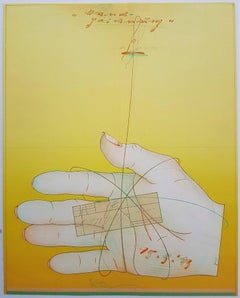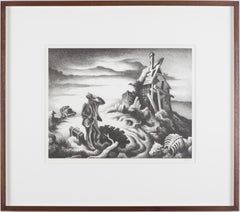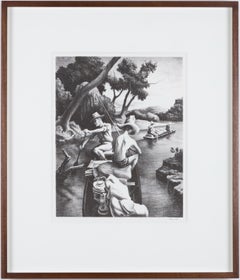Wolfgang Oppermann Prints and Multiples
b. 1937
Wolfgang Oppermann was a German painter, graphic artist and sculptor of pop art and conceptual art. He was married to the artist Anna Oppermann. Both influenced each other in their work.
to
1
Overall Width
to
Overall Height
to
1
1
1,174
925
886
814
1
1
1
1
1
1
Artist: Wolfgang Oppermann
Handzeichnung
By Wolfgang Oppermann
Located in Kansas City, MO
Wolfgang Oppermann
“Handzeichnung”, 1975
Colored lithograph
Edition: 61 / 222
Signed in Pencil
Size: 19.5 x 15.5 inches
Wolfgang Oppermann (born September 19, 1937 in Hamburg , † March 11, 2001 ibid) was a German painter , graphic artist and sculptor of pop art and conceptual art . He was married to the artist Anna Oppermann...
Category
1970s Modern Wolfgang Oppermann Prints and Multiples
Materials
Lithograph
Related Items
Prodigal Son
By Thomas Hart Benton
Located in London, GB
A man raises his hand to his chin, his neck tilted and face turned to look at a dilapidated farmhouse, barely held together by planks of wood and exposed to the elements. Behind him ...
Category
1930s American Modern Wolfgang Oppermann Prints and Multiples
Materials
Lithograph
Down the River
By Thomas Hart Benton
Located in London, GB
In this sentimental work from 1939, Benton expresses his admiration for the rural lifestyle of the Midwest. He highlights the connection between man and the land by depicting two fig...
Category
1930s American Modern Wolfgang Oppermann Prints and Multiples
Materials
Lithograph
“Winter” from the “Four Seasons Suite” Series
By Alvar Sunol Munoz-Ramos
Located in San Francisco, CA
This embossed, numbered and signed lithograph, part of the “Four Seasons Suite,” is by Alvar Suñol Muñoz-Ramos (b. 1935), a renowned Spanish ar...
Category
1970s Modern Wolfgang Oppermann Prints and Multiples
Materials
Paper, Lithograph
$1,350
H 37.25 in W 30.5 in D 2 in
Discussion
By Thomas Hart Benton
Located in London, GB
In this charming regionalist lithograph, Benton captures a classic Midwestern American scene: two men talking, drinking, and smoking together in a bar. Titled 'Discussion', the artwo...
Category
1930s American Modern Wolfgang Oppermann Prints and Multiples
Materials
Lithograph
"Labor in a Diesel Plant" Machine Age American Scene Industrial Mid 20th Century
By Letterio Calapai
Located in New York, NY
"Labor in a Diesel Plant" Machine Age American Scene Industrial Mid 20th Century
Letterio Calapai (American 1902-1993)
''Labor in A Diesel Plant''
Wood engraving, 1940
17 x 10 1/2...
Category
1940s American Modern Wolfgang Oppermann Prints and Multiples
Materials
Lithograph
$6,900
H 23 in W 16 in D 2 in
Picasso and the Human Comedy, Verve Lithograph Print, 1954 Original lithograph
By Pablo Picasso
Located in London, GB
Picasso and the Human Comedy, Verve, Vol. VIII, No 29/30, 1954
Original lithographs published by Mourlot Frères
Original lithograph print from Verve Vol. VIII, No 29/30 printed by t...
Category
Mid-20th Century Modern Wolfgang Oppermann Prints and Multiples
Materials
Lithograph
$1,342
H 16.15 in W 20.08 in D 0.79 in
Picasso and the Human Comedy, Verve Lithograph Print, 1954 Oringinal Lithograph
By Pablo Picasso
Located in London, GB
Picasso and the Human Comedy, Verve, Vol. VIII, No 29/30, 1954
Original lithographs published by Mourlot Frères
Original lithograph print from Verve Vol. VIII, No 29/30 printed by t...
Category
Mid-20th Century Modern Wolfgang Oppermann Prints and Multiples
Materials
Lithograph
$1,342
H 16.15 in W 20.08 in D 0.79 in
Old Man Reading
By Thomas Hart Benton
Located in London, GB
Accompanied by a lantern, an elderly man sits alone, engrossed in a newspaper. Benton used a lithographic process to draw and produce this image. He renders the face and paper well-l...
Category
1940s American Modern Wolfgang Oppermann Prints and Multiples
Materials
Lithograph
“Europa and the Bull”
By Alvar Sunol Munoz-Ramos
Located in San Francisco, CA
You have to hand it to the bull. Not just taking Europa with his unassailable power (he is Zeus in disguise, after all) he brings along a retinue for his seduction of the beautiful P...
Category
1980s Modern Wolfgang Oppermann Prints and Multiples
Materials
Paper, Lithograph
Vintage SIGNED Kitaj Poster, La Fabbrica, Milan (A Life 1975) woman in red dress
By Ronald Brooks Kitaj
Located in New York, NY
Printed in 1975, this poster features the encounter between an alluring woman dressed in red, and a man with his back to the viewer. The light of a streetlamp is beautifully imitated...
Category
Late 20th Century Modern Wolfgang Oppermann Prints and Multiples
Materials
Lithograph
Wifredo Lam (7303) Taureau trois graines s est laisee pousser les dents, 1973
By Wifredo Lam
Located in Miami, FL
Wifredo Lam
(7303) Taureau trois graines s est laisee pousser les dents, 1973
Lithograph
EC
25 x 19 in
Category
1970s Modern Wolfgang Oppermann Prints and Multiples
Materials
Lithograph
From “The Four Seasons Suite” Series
By Alvar Sunol Munoz-Ramos
Located in San Francisco, CA
This hand-signed, limited-edition lithograph with embossing is by the renowned Catalan Modernist artist Alvar Suñol Muñoz-Ramos, commonly known as Alvar. Part of “The Four Seasons” s...
Category
1970s Modern Wolfgang Oppermann Prints and Multiples
Materials
Paper, Lithograph
$1,350
H 37.25 in W 30.5 in D 1.5 in
Previously Available Items
Handzeichnung
By Wolfgang Oppermann
Located in Kansas City, MO
Wolfgang Oppermann
“Handzeichnung”, 1975
Colored lithograph
Edition: 61 / 222
Signed in Pencil
Size: 19.5 x 15.5 inches
Wolfgang Oppermann (born September 19, 1937 in Hamburg , † March 11, 2001 ibid) was a German painter , graphic artist and sculptor of pop art and conceptual art . He was married to the artist Anna Oppermann...
Category
1970s Modern Wolfgang Oppermann Prints and Multiples
Materials
Lithograph
Wolfgang Oppermann prints and multiples for sale on 1stDibs.
Find a wide variety of authentic Wolfgang Oppermann prints and multiples available for sale on 1stDibs. You can also browse by medium to find art by Wolfgang Oppermann in lithograph and more. Much of the original work by this artist or collective was created during the 1970s and is mostly associated with the modern style. Not every interior allows for large Wolfgang Oppermann prints and multiples, so small editions measuring 16 inches across are available. Customers who are interested in this artist might also find the work of Sergio Barletta, John DePol, and Riccardo Tommasi Ferroni. Wolfgang Oppermann prints and multiples prices can differ depending upon medium, time period and other attributes. On 1stDibs, the price for these items starts at $350 and tops out at $350, while the average work can sell for $350.



